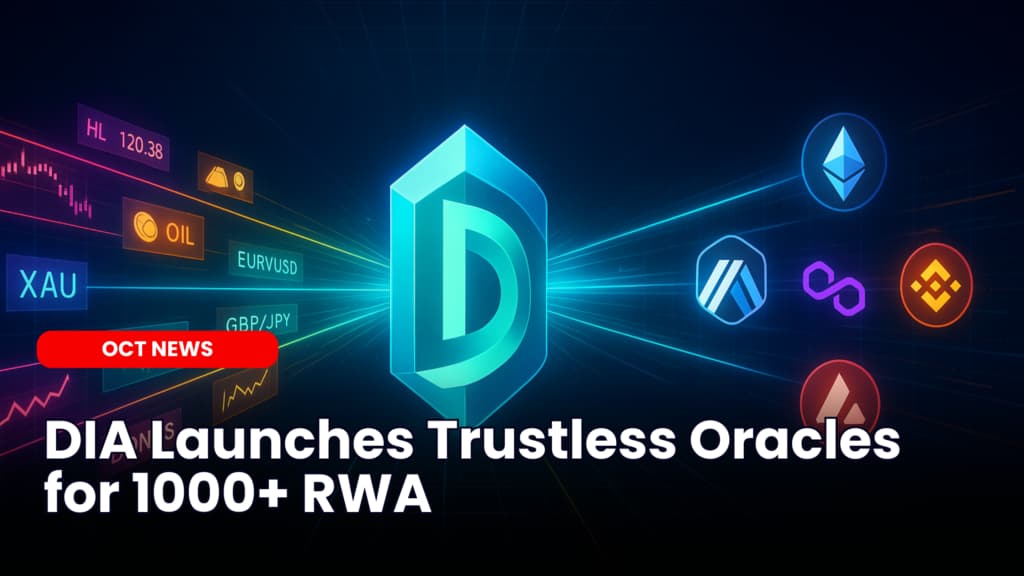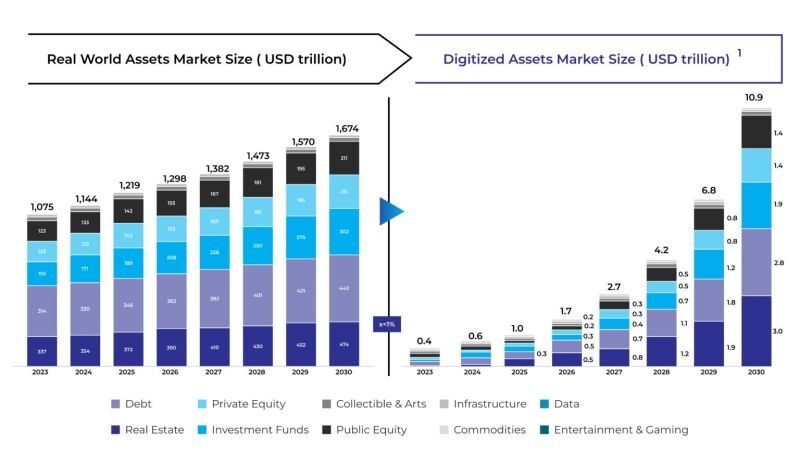
DIA unveils DIA xReal, trustless oracles for 1,000+ real-world assets for enhancing DeFi transparency and fueling the $10T RWA market
Author: Chirag Sharma
Published On: Wed, 27 Aug 2025 23:04:13 GMT
August 27,2025, DIA has launched DIA xReal, the industry’s first comprehensive oracle suite for RWA. Powered by its Lumina rollup infrastructure, the suite delivers fully auditable, onchain price feeds for over 1,000 assets. including stocks, commodities, forex pairs, bonds, and yields. With tokenized RWAs projected to hit $10 trillion by 2030, DIA’s move could reset the standards for transparency and trust in DeFi.
The tokenized RWA market has expanded rapidly, covering assets such as treasury bills, carbon credits, and equities. This growth comes with a critical flaw: unverifiable data. Existing oracle providers supply feeds without transparency on sourcing or calculation, forcing protocols to rely on blind trust.
DIA’s xReal is aiming to address this by shifting all processes including weighted averages, outlier detection, and aggregation is onchain. But with Lumina’s sub-second block times, every calculation is fully auditable, ensuring cryptographic proof of accuracy. This closes the trust gap and enables new applications like tokenized ETF vaults, parametric climate insurance, and real estate tokens with verifiable yields.
DIA xReal is rolling out across ten+ blockchain ecosystems, including SonicLabs, Linea, and Alephium. It is offering consistent, trustless infrastructure across networks. Beyond generic feeds, protocols can request custom oracle sets, giving flexibility for tailored products.
The suite spans traditional markets like the S&P 500 and NASDAQ, commodities like gold and oil, and even emerging-market FX pairs. By removing trust assumptions, DIA is promises to position itself as a key enabler of the RWA boom. Analysts are projecting the tokenized asset sector to hit $10T by 2030.

From powering real-time FX for remittances to yield-bearing real estate tokens, DIA’s trustless approach could potentially set a new benchmark for oracle infrastructure.
<!-- OCT Shiny FAQ (Stacked Layout) -->
<div class="oct-faq" style="--bg:#ffffff; --text:#0f0f12; --muted:#6b7280; --brand:#0099ff; --ring:#d2eaff; --card:#ffffff; --border:#edf0f5">
<h3 class="oct-faq__title">Frequently Asked Questions : DIA Oracles and RWA</h3>
<details class="oct-faq__item" open>
<summary>
<span class="q">What is DIA xReal?</span>
<span class="chev" aria-hidden="true"></span>
</summary>
<div class="a">
DIA xReal is the first comprehensive trustless oracle suite for real-world assets, delivering auditable onchain price feeds for over 1,000 assets, including stocks, commodities, and bonds.
</div>
</details>
<details class="oct-faq__item">
<summary>
<span class="q">Why are trustless oracles important for RWAs?</span>
<span class="chev" aria-hidden="true"></span>
</summary>
<div class="a">
Traditional oracles often lack transparency, forcing protocols to trust unverifiable data. DIA xReal eliminates this by performing all calculations onchain, ensuring accuracy and auditability.
</div>
</details>
<details class="oct-faq__item">
<summary>
<span class="q">Which blockchains will integrate DIA xReal?</span>
<span class="chev" aria-hidden="true"></span>
</summary>
<div class="a">
Major ecosystems like Ethereum, Arbitrum, Polygon, BNB Chain, and Avalanche are confirmed, with additional rollouts across SonicLabs, Linea, and Alephium.
</div>
</details>
<details class="oct-faq__item">
<summary>
<span class="q">What use cases does DIA xReal enable?</span>
<span class="chev" aria-hidden="true"></span>
</summary>
<div class="a">
It unlocks new DeFi primitives, including tokenized ETF vaults, parametric climate insurance, sovereign debt instruments, remittances, and tokenized real estate with verifiable yields.
</div>
</details>
<details class="oct-faq__item">
<summary>
<span class="q">How big is the RWA market opportunity?</span>
<span class="chev" aria-hidden="true"></span>
</summary>
<div class="a">
The tokenized RWA sector is currently valued at ~$25 billion but is projected to grow to $10 trillion by 2030, making verifiable oracle infrastructure critical for scaling.
</div>
</details>
</div>
<style>
/* Container */
.oct-faq{
background: var(--bg);
color: var(--text);
border: 1px solid var(--border);
border-radius: 20px;
padding: 22px;
position: relative;
isolation: isolate;
overflow: hidden;
}
.oct-faq:before,.oct-faq:after{
content:""; position:absolute; z-index:-1; filter:blur(40px); pointer-events:none;
}
.oct-faq:before{
width:420px; height:420px; right:-160px; top:-160px;
background: radial-gradient(closest-side, color-mix(in srgb, var(--brand) 15%, transparent) 0%, transparent 70%);
}
.oct-faq:after{
width:360px; height:360px; left:-140px; bottom:-140px;
background: radial-gradient(closest-side, color-mix(in srgb, var(--brand) 10%, transparent) 0%, transparent 70%);
}
.oct-faq__title{
margin:0 0 12px;
font:800 20px/1.2 ui-sans-serif,system-ui;
letter-spacing:.2px;
}
/* FAQ card stacked */
.oct-faq__item{
margin-bottom:14px;
border:1px solid var(--border);
border-radius:16px;
background: linear-gradient(180deg, rgba(255,255,255,.96), rgba(255,255,255,.90));
box-shadow:
0 12px 30px rgba(0,0,0,.06),
0 1px 0 rgba(255,255,255,.6) inset;
overflow:hidden;
transition:border-color .2s ease, box-shadow .2s ease;
}
.oct-faq__item[open]{
border-color: color-mix(in srgb, var(--brand) 20%, var(--border));
box-shadow:
0 16px 36px rgba(0,0,0,.08),
0 0 0 1px color-mix(in srgb, var(--brand) 12%, transparent) inset;
}
/* Summary row */
.oct-faq__item > summary{
list-style:none;
cursor:pointer;
padding:14px 16px;
display:flex; align-items:center; justify-content:space-between; gap:12px;
position:relative;
}
.oct-faq__item > summary::-webkit-details-marker{display:none}
/* Brand accent bar */
.oct-faq__item > summary:before{
content:""; position:absolute; left:0; top:0; bottom:0; width:3px;
background: linear-gradient(180deg, var(--brand), color-mix(in srgb, var(--brand) 70%, white));
}
/* Question text */
.oct-faq .q{
font:800 15px/1.3 ui-sans-serif,system-ui;
color:var(--text);
}
/* Chevron */
.oct-faq .chev{
width:22px; height:22px; border-radius:6px;
background:
radial-gradient(circle at 30% 30%, var(--ring), transparent 60%),
#fff;
border:1px solid var(--border);
box-shadow:0 4px 12px rgba(0,0,0,.06);
position:relative; flex:0 0 auto;
}
.oct-faq .chev:before{
content:""; position:absolute; inset:0; margin:auto; width:8px; height:8px;
transform: rotate(45deg);
border-right:2px solid var(--brand); border-bottom:2px solid var(--brand);
transition: transform .2s ease;
}
.oct-faq__item[open] .chev:before{ transform: rotate(-135deg); }
/* Answer */
.oct-faq .a{
padding:0 16px 14px 16px;
color:var(--muted);
font:400 14px/1.6 ui-sans-serif,system-ui;
border-top:1px dashed #eef2f6;
animation: faq-reveal .25s ease;
}
@keyframes faq-reveal{
from{opacity:0; transform:translateY(-4px)}
to{opacity:1; transform:translateY(0)}
}
</style>Real voices. Real reactions.
Our Crypto Talk is committed to unbiased, transparent, and true reporting to the best of our knowledge. This news article aims to provide accurate information in a timely manner. However, we advise the readers to verify facts independently and consult a professional before making any decisions based on the content since our sources could be wrong too. Check our Terms and conditions for more info.

